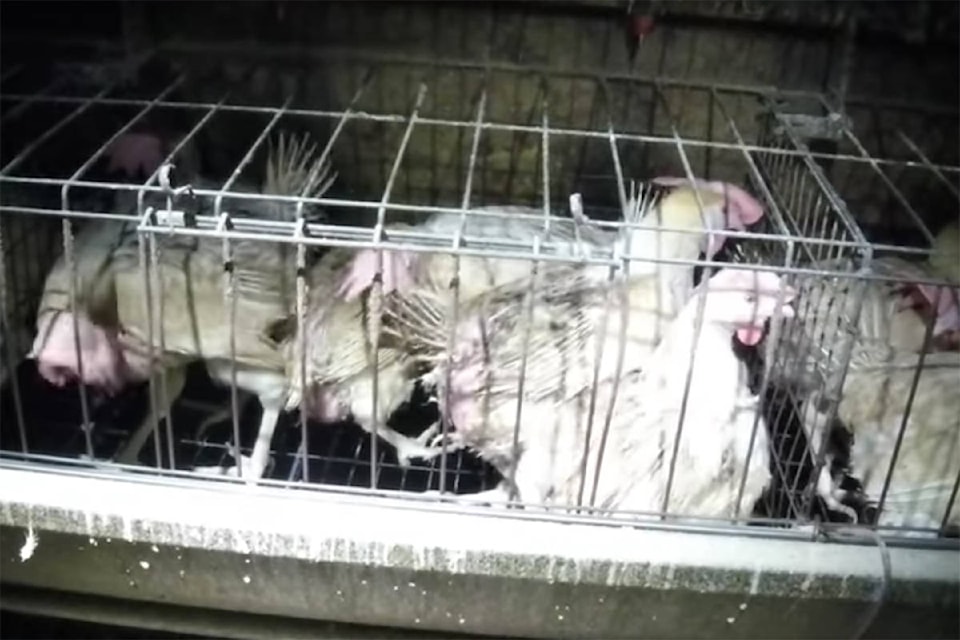A disturbing video allegedly showing hens trapped in a manure pile in an Abbotsford barn has prompted a series of investigations, even as questions are raised about its veracity.
The video was taken by a local animal rights activist, allegedly at three Fraser Valley egg farms.
Released on the PETA (People for the Ethical Treatment of Animals) website, the organization says hundreds of dead birds were found at the farms, some enclosed alongside live birds and others buried in manure pits beneath the cages that had held them. But the video’s veracity has been called into question by a panel of animal health experts.
As of press time, The News had neither been able to verify the credibility of the video, nor spoken with the man who shot it.
A lawyer responding to a request for comment said she had reviewed more footage and the video was legitimate and had prompted a raid by the BC SPCA.
Katie Lowe, the executive director of the BC Egg Marketing Board, said the footage had prompted audits of animal health practices at two of the farms. She said the board hadn’t spoken to the man who shot the video, and hadn’t identified the third location.
Inspectors have been sent to the farms mentioned, and the boards have also brought in a third-party auditor to survey the sites’ animal care programs.
Egg Farmers of Canada also had an auditor at the locations. On Tuesday, an investigative panel visited the two farms.
Each farm must follow an animal care program and is subject to annual inspections. If birds are in distress, farms have 48 hours to fix things. If they don’t, a board can pull a farm’s licence, although the BC Egg Marketing Board has never needed to take that final step, Lowe said.
She had not yet seen the inspection reports, but Lowe said the video showed unacceptable levels of care.
“The conditions on the farm were not typical of a normal farm, and we do expect more of our producers,” Lowe said. “We’re taking this very, very seriously.”
She also pointed to a panel of experts that was convened by the Canadian Centre for Food Integrity to look at hidden-camera footage that raised questions about the credibility of the video.
The four all said the images were disturbing, but also raised questions about the footage, noting the video was highly edited and seemed to show different types of birds in multiple barns.
Two of the experts expressed skepticism about footage of birds that are stuck in manure, but clean on top.
“It is very unusual for a bird that gets in a manure pit to not be dirty on their back feathers and head,” wrote poultry veterinarians Dr. Tom Inglis and Dr. Ben Schlegel.
Two others noted that the narrator says hundreds of birds had been trapped, but only two are shown in the video, which is two minutes, 36 seconds long.
“What I found extremely odd is the only wet, mushy areas appear to be where the birds are ‘trapped’ yet everything else around it is dry,” said Jennifer Woods, another panel member.
But Anna Pippus, a lawyer for Animal Justice who responded to a request for comment from the man who shot the video, said the Canadian Centre for Food Integrity’s (CCFI) skepticism has been proven wrong in the past.
“The CCFI often claims videos of animal cruelty have been staged following their assessment of a brief edit designed for public dissemination,” she wrote in an email. “In every single such instance, veracity has been authenticated with careful documentation, extended footage not publicly available, and investigations by law enforcement. It is irresponsible and possibly illegal for CCFI to make such sweeping, decisive defamatory claims on the basis of so little information.”
Pippus said: “The raw footage shows clearly that birds at each of these facilities were living below the cages in manure pits in various stages of illness and decomposition. Some were still walking around while others were trapped in manure to varying degrees. Twenty-one brown hens were removed from one facility, and three and eight leghorn hens from the other two facilities, respectively.”
Warning: The video below contains graphic content.
